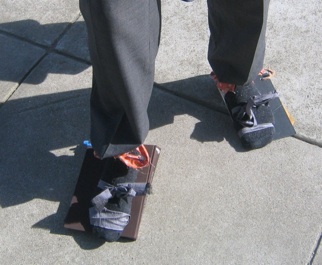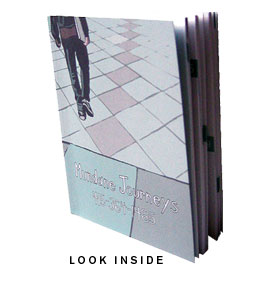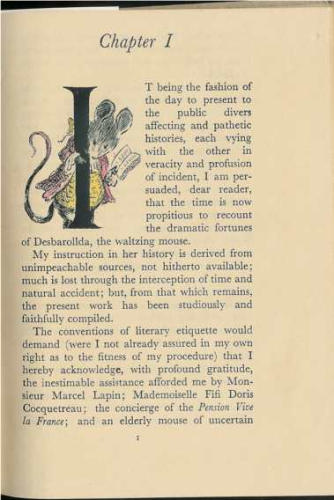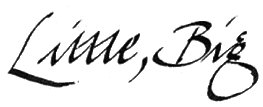

The Biographer as Unreliable Narrator
Follow My Dust ! A Biography of Arthur Upfield by Jessica Hawke (Heinemann, 1957) is a very curious and slippery book. I have read few biographies whose factual content is to be measured in counted syllables. I suppose that I should have been alerted when I noticed the photographs in the book include Australian fauna and desolate landscapes rather than the author at different ages. It’s a readable, interesting picture of Australia in the first half of the twentieth century, with lots of vivid landscape, quirky characters, and unusual incident — not unlike an Arthur Upfield novel — but it is decidedly thin on concrete chronology and just plain fact. But it succeeds in conveying the fact that Upfield only became himself by leaving the rigidity of expectations of Edwardian England. The account appears to stop about 1939 and then crams the next dozen years into about five scant paragraphs. A typed slip in my copy states that the author was Upfield’s de facto wife for many years and that the book was mostly written by Upfield. The University of Melbourne Library holds his Papers and there is a detailed description of the contents of the collection, with a brief, objective biographical note that confirms Upfield’s authorship of Follow My Dust !
The only other biographical work of comparable evasiveness that I have read is Without Stopping by Paul Bowles — was it William Burroughs who referred to it as Without Telling ? — but with Bowles that is only to be expected.
25 February 2007
In the coming week I intend to gather impressions of books people are reading on public transport : train, subway, ferryboat, bus. Whether this will take form as raw statistical data or covert images or mere glimpses of author and title remains to be seen. The methodology is still fluid, but excludes newspapers and magazines. I will be impartial (and will record as a separate item what I am reading) ; just how theatrical I will be in conducting this survey will also be defined as I go along. My commute takes me from suburban New Jersey into Manhattan by a series of decision trees involving time, weather, rivers, trains, forking paths, and factors beyond my control ; I invite readers to send lists (or images) of books seen on public transport to me : wessells [at] aol [dot] com.
Today I have been reading Istanbul. Memories and the City by Orhan Pamuk, translated from the Turkish by Maureen Freely (Knopf, 2006) and Follow My Dust ! A Biography of Arthur Upfield by Jessica Hawke (Heinemann, 1957). I have read a couple of Pamuk’s novels, and heard the December BBC interview (in effect an English translation of his Nobel Prize speech) ; some years ago I read several of Upfield’s detective novels. More on these anon.
24 February 2007
Yardsticks ; or how to compare Apples & Oranges
While reading a forthcoming collection of short stories, Portable Childhoods by Ellen Klages (Tachyon, 2007) and making notes towards a review, I began to think about the way I look at short fiction and the authors whose work informs my own reading of short stories (and writing about them). This is a first list, no doubt it will be expanded :
Robert Sheckley (wit, and
whenever I need to rattle my brains to take a fresh approach)
Jorge Luis
Borges (deliberate use of language, concision, and integrating scholarship
into fiction)
R. A. Lafferty (inventiveness, the vernacular touch, and integrating the
appearance of scholarship into fiction)
Lydia
Davis (dexterity in simplicity and rendering domestic matters in resonant
language)
Ursula K. Le Guin (inventiveness and playfulness and sense of politics)
Fredric Brown (short short stories, tight plotting, irony)
J. G. Ballard (chilly narrative control, formal innovation to concrete
effect)
Paul Bowles (sucessful use of exotic locales and the clash of cultures)
Raymond Chandler (event, simile, and sparkling prose)
William S. Wilson (integrity of form and function, precision of language and idea)
I have included a few notes about what it is I see in these writers’ work that makes me count them as a standard of excellence. For me, the short stories of these writers (read and sometimes re-read over a period of years) really function as a string of landmarks that allow me to navigate the forests of story. And yet that is not quite the image I intend, for landmark is too static a word to describe a process of allusion — and when reading one author, I cannot predict where and when I might be prompted to think of another author. Perhaps what I draw from my familiarity with these writers’ work is a choreography, notes on the dance of story. When I cite these names or a specific story, it is not to say that X writes like Y but to evoke instances and effects of similar power or subtlety or pleasure.
To a somewhat lesser degree, the stories of Steve Katz, Michael Brownstein, Harlan Ellison, Thomas M. Disch, and Guy Davenport (for example) are part of this choreography. At some point along the way, I have read most of the short fiction of Wells, Hammett, Maugham, Wodehouse, and Hemingway (for example, again), but I don’t usually make much reference to their work.
Curiously, for all I admire the work of Phillip K. Dick — especially the novels Time out of Joint and Valis — and keep a copy of the five-volume Collected Stories on an accessible shelf, I do not often find myself summoning an effect, an image, or an approach from Dick’s stories for critical purposes. I am more likely to call on Fletcher Pratt (chiefly The Well of the Unicorn and The Blue Star ) for frame story issues, politics in fantasy, and conflicted heroes. Similarly, while I can often turn up an analogue from Avram Davidson’s stories, I do not often employ his work as a yardstick. The closing cadences of James Joyce’s “ The Dead ” are potent but, again, I do not often find reason to invoke them.
As I have been thinking about the choreography markers, I have identified a few authors whose short stories I shall probably more systematically in the coming year : Kipling, Gene Wolfe, Katherine Anne Porter, Brian Aldiss.
On Monday I went to SFMOMA and saw the biennial award show for the Society for the Encouragement of Contemporary Art (SECA), which features, among others, the work of San Francisco artist Amy Franceschini. Her project, Victory Gardens, encourages the spread of vegetable gardens in the urban environment and subversively transforms older ideas of the victory garden. Rose Miller reports about it for Worldchanging, here, (with a picture). I went because of my brother’s involvement in the pratical gardening aspects of the project. He’s the one riding the bikebarrow in the video :
[I have not figured out how to make the video pop up in a smaller (optimum size) window.]
The really wonderful part of this project is that it is just beginning.
17 February 2007 (San Francisco, Calif.)
Walking around in Books (Pt. II)
A midday post after this morning’s weedwalk / book & color walk. Michael
Swaine, Archie Wessells and about a dozen participants gathered at the big
bow and arrow for a weedwalk towards the foot of of the Bay bridge and thence
to Brannan street.
The footwear was stylish ; the sounds of cloth rubbing on cement were distinctive ;
I have been interested in mandrakes ever since I read Avram Davidson’s essay, “ Who Makes the Mandrakes ? ” in Adventures in Unhistory (Owlswick, 1993 ; 2nd ed., Tor, 2006) and the passage where Vergil Magus consults the potted mandrake in The Phoenix and the Mirror (Doubleday, 1969). John Donne’s Song is another resonant literary allusion (here from the 1635 edition) :
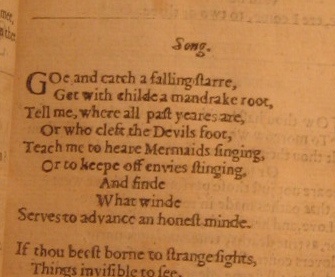
Here is a picture of of a mandrake currently in bloom :
and a detail of the blossoms :
My brother and I share this interest and have carried it well beyond the logical, to the absurd, as our recent Hallowe’en costumes demonstrate :

See you tomorrow at the Weedwalk or the book fair.
Weedwalk
color/book walk this saturday
[17 February 2007]
walkers of the world unite. for saturday at least. sorry as usual there is short to no notice. saturday morning we will meet kate pocrass and henry wessells at the big arrow and bow near the ferry building [embarcadero stop on bart]. nine a.m. good blue bottle coffee kiosk is nearby. email shoe size to swaineedward [at] yahoo.com
14 February 2007 (Vallejo, Calif.)
A Small Book with Vast, Subtle Implications
On an earlier visit to the San Francisco bay area, my brother gave me a copy of a small book full of big ideas : Mundane Journeys. An Eagerness to Interact with Strangers in Common Atmospheres by Kate Pocrass and Patrick J. Kavanagh (Mundane Journeys, 2004).
I was impressed by the book’s alertness to unusual aspects of urban life and its emphasis on spontaneity and close observation of the ordinary. I liked Mundane Journeys sufficiently to give away a number of copies — and one couple to whom I sent it brought the book along as the only guidebook for their visit to San Francisco. On my daily commute and in my travels I think about the ideas that Pocrass articulates ; for me, it is taking one small, quiet step off to the side, paying attention to the peripheries, and trying to see what’s actually there — out the train window, on the street corner or building wall, or watching the changing seasons — instead of marching in the mathematical footsteps of Phileas Fogg (who did, it should be remembered, abandon his rigid program at a telling moment ; and, as a result, ultimately won his bet when things seemed darkest).
This is an ongoing interest. Back when Temporary Culture was a photocopy ’zine, I was interested in the small alleys and forgotten streets of north Philadelphia and the lower east side of Manhattan ; one collaborative project arose when I wrote from memory a series of image poems on the nine Muses section of New Orleans and a friend, Demetrios Dowland, took photographs in the same district (without reading the poems) ; there were some startling collisions of word and image, memory and reality. That collaboration was reprinted in Exquisite Corpse .
Accordingly, I am very pleased to convey the following announcement from Weedwalk :
Weedwalk
color/book walk this saturday
[17 February 2007]
walkers of the world unite. for saturday at least. sorry as usual there is short to no notice. saturday morning we will meet kate pocrass and henry wessells at the big arrow and bow near the ferry building [embarcadero stop on bart]. nine a.m. good blue bottle coffee kiosk is nearby. email shoe size to swaineedward [at] yahoo.com
13 February 2007
The Library under the Stairs :
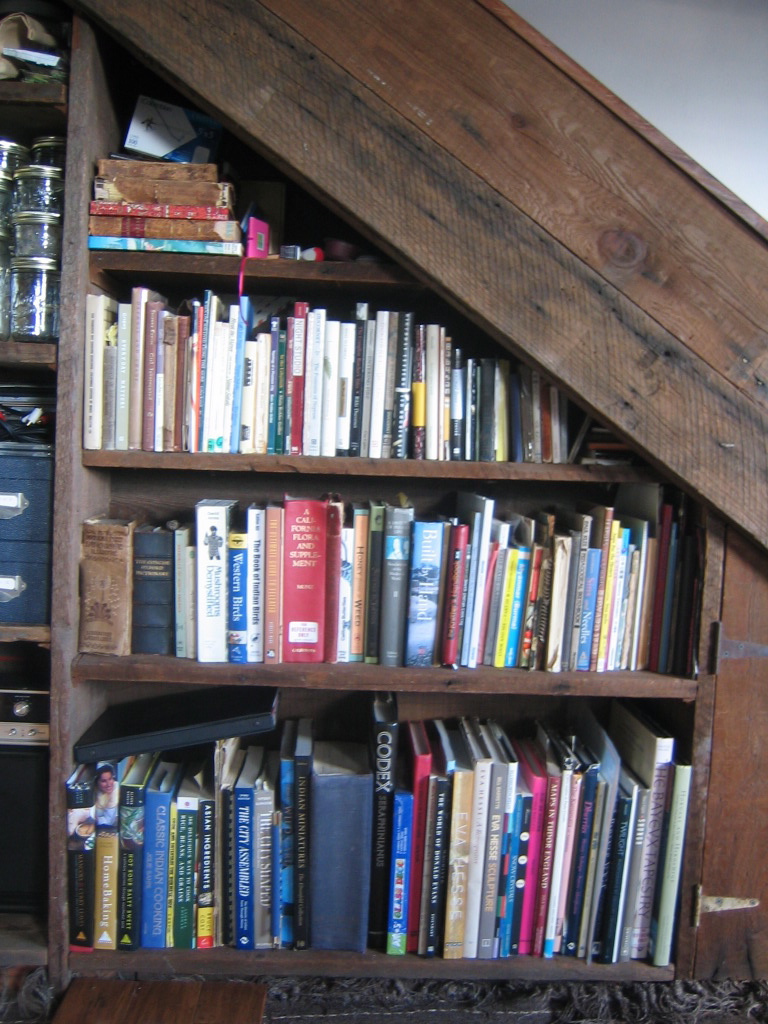
The Circulation Department :
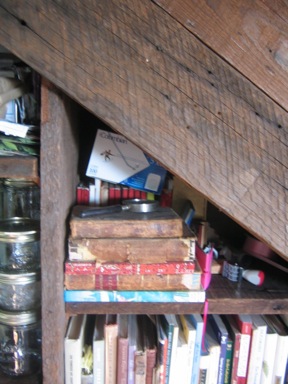
Mrs. Amelia Lincoln’s Familiar Lectures on Botany . . . (1841) :
In designing the botanical ornaments for Another green world (2003), I adapted images from Familiar Lectures on Botany . It’s a pleasure to see the book again, and to notice the mid-nineteenth-century American binding style on a shelf :
12 February 2007
Short note today as I am packing for travel : a link to Neil Gaiman’s blog with an interesting paragraph about The True and Pathetic History of Desbarollda the Waltzing Mouse by Noel Langley (Lindsay Drummond, 1947), with picture :
Tomorrow I will be en route to the San Francisco area for the California International Antiquarian Book Fair, to be held Friday though Sunday (16 - 18 February) at the Concourse Exhbition Center 7th and Brannan Streets. James Cummins Bookseller will be in booth 421.
11 February 2007
Bibliomancy ; or, How I Walk around in Books
Once upon a time, O Best Beloved, T. S. Eliot wrote the dust jacket copy for Faber & Faber, but Ol’ Tom has been gone for half a century, and there are not his likes in the biz now. The perty pitchers sure are nice, and it is instructive to see who will gush, and how. I speak as one who has provoked a few interesting blurbs. (Teresa Nielsen Hayden offers a very useful perspective on book covers as advertising posters applied to each book in a handy portable fashion.)
But the blurb is not the book, so after noting aspects of the form of the container, I disregard the seductions of the covers and turn to the title page and front matter. Who ? Where ? and, Is it legible ? By legibility I do intend something a bit more subtle than the brute criterion stated by Roldry Mud, Prince Vlox :
Lots of chaps want to know about a book, ‘ Is it spicy ? ’ Some want to know, ‘ Is it got lots of facts ? ’ What I want to know only is, ‘ Has it got big print ? ’ Shan’t risk spoiling my eyes and having to wear a monocle. (Avram Davidson, “ The Odd Old Bird ”)
I am
still at the stage of thinking about the container, the white spaces, the
feel
of paper, and the general presentation of the words on the page. These
are subjective matters, but it is the difference between a book that is
a pleasure to read and a book that gives the sense of being in a room where the light bulbs are just a little too dim, or a book that one leaves as quickly as possible, as from a confining space.
And then it is time to turn to the contents, to open the door that is
the title page and enter the rooms beyond. There is still time to appreciate
form and function : does the door open readily ? will the book
as object enable or hinder its own use ? I like half-titles, fly-titles,
and publishers generous enough to give a page to the dedication, epigrams,
or whimsies. Novels do tend to have fewer corridors and anterooms, and
so one enters the text directly.
Critical
editions,
standard editions of classics, and short story collections share some
of the structures of nonfiction books : the front matter announces
how well integrated design and text will be. Even in deciding to leave
the introductions alone and leaf directly to the beginning of the novel,
the reader will observe the underlying architecture. It may be on the
level of what one notices walking quickly though one part of a museum
to reach a particular room, or the experience of walking through a subway
tunnel or waiting in the lobby of a hotel furnished to a standard, interchangeable
design :
that will depend on the book.
The back end is worth looking at, too : the colophon that records
information or pretence ; the bibliography, notes and index. In
“ The
Index ” (1977), J. G. Ballard demonstrated how much one can
fabricate history through crafty suggestion, but in most works of nonfiction
the
index
remains a good place to start. And in certain discursive styles of
note, one will find that an author states ideas far more concisely than
in
the main text. Fiction with footnotes ? what joy ! When
I heard Susanna Clarke read from Jonathan Strange & Mr Norrell , she
mentioned that the novel started in the footnotes.
And so to the text. I know some folks who smell their books, but not
me. With nonfiction, I will pick a page or two on the basis of the index,
or by chance, to sample before entering the author’s ideas : looking at the windows or eaves before entering a house. Fiction I
start at the beginning, novels anyway ; while in the case of story
collections, I will use some sort of aleatory or randomizing method.
The Bookshelves on the Stairs

Later this coming week I will be in the San Francisco area for the California International Antiquarian Book Fair, to be held Friday though Sunday (16 - 18 February) at the Concourse Exhbition Center 7th and Brannan Streets. James Cummins Bookseller will be in booth 421.
Very interesting essay on influences, creative borrowing, and the “ plundered, fragmentary state ” of literature by Jonathan Lethem, “ The Ecstasy of Influence ”, from Harper’s . I have only been glancing through this ; it warrants closer study. This is a topic closely connected with all my fiction writing ; and Lethem cites some writerly heroes whose work I admire. More anon.
9-10 February 2007
It’s
February and there’s no snow on the ground outside my windows.

Recent Arrivals
Love in the Kingdom of Oil by Nawal El-Saadawi. Translated
from the Arabic by Basil Hatim and Malcolm Williams (Saqi Books, 2001)
Of Dreams and Assassins by Malika Mokeddem. Translated
[from the French] and with an Introduction by K. Melissa Marcus (University
Press of Virginia, 2000)
Dangerous Knowledge. Orientalism and Its Discontents by
Robert Irwin (Overlook Press, 2006) [First published in England as: For Lust of Knowing. The Orientalists and their Enemies (Allen
Lane, 2006)]
A Gazelle |
 |
7 February 2007
Pas un mot
Pas un mot — “ not one word ” is
a very interesting entry
in the Dictionnaire égoïste de la littérature française by
Charles Dantzig (Grasset, 2005), in which the significance of the deliberate
omission in memoirs and critical writings is considered. Chateaubriand says not
a word on Stendahl, notes Dantzig, although both were eccentric writers and minor
diplomats in Italy. What we avoid returns, says Dantzig, “ Ce dont
un auteur ne
parle pas ne compte pas autant que ce qu’il dit. Mais cela le complète.
Et n’a de valeur qu’en ce qu’il cache. ” What
an author does not speak of is not as important as what he says, but does supplement
it. Its only worth consists in what he conceals.
I know that there are certain
writers of whom I tend to write very little. When once I proposed the Golden
Nutmeg
award “ for an outstanding work of fiction or nonfiction published
in the preceding
year that combines good writing, eclectic scholarship, and wit ”,
more or
less
within the tradition of Avram Davidson’s essays and fictions, Reno Odlin
suggested
that
I entertain nominations for a wooden nutmeg award ; I responded with all
due respect, there are enough good books clamoring for attention that
this suggestion must await a more leisured period.
I still feel the same way, and would rather devote my energies to something that
rewards my efforts or challenges me to think, than discuss books that fail to
reach me — except when I come across an example of narrative dishonesty
that makes my blood boil. This is tricky, for past incidents have usually been
discarded before
any mention appears on the Endless Bookshelf. I am reminded, however, of the
way in which the author of The Coffee Trader (Random House, 2003 ;
I believe I read it in a Ballantine paperback), David Liss, actually writes
about how his main character has an idea, while
withholding that crucial idea from the reader . At that point, I scribbled something in the margin and discarded the book. There is no perhaps :
I take seriously the relationship of trust that the writer must create to earn
the reader’s willing suspension of disbelief.
Well, I had just been getting ready for the annual meeting with my tax preparer,
and all is in order now (even concerning the tuppence-ha’penny profit that Temporary
Culture made). Much as I might have liked to go off on a whimsical digression
about the Swallows & Amazons books by Arthur
Ransome or another similar topic, I though it more fun
to offer an evasive take on the question of what books or authors
are unlikely
to
be
mentioned
in these musings.
And someday soon, dear readers, I promise, I will figure out how to integrate
a
comment
function into the website. In the meantime, send e-mail. And go look at the archives .
Tomorrow, Thursday 8 February (7 : 00 p.m.), at the Swiss Institute — Contemporary Art, 495 Broadway, 3rd Fl., N.Y.C. (T. 212.925.2035) I will be reading the Arabic originals of poems by Abdelkrim Tabal translated by Rabia Zbakh and Wendy Walker (who will read the English poems). Other readers include translators Emily Moore and Matthew Zapruder reading poetry translated from Spanish and Romanian.
6 February 2007
A Title is not a Book
One attentive reader of the earlier Endless Bookshelf reading log commented,
That book Thrift
Store is on your list twice. Well, yes, the title appears twice ;
but that is because there are two different books by the same
author with the same title.
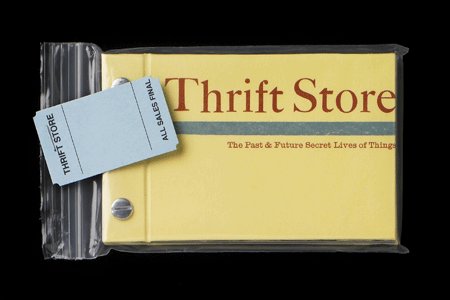
The original Thrift Store. The Past and Future Secret Lives of Things (Red Charming, 2003) is a small handmade book produced in an edition of 50 copies by book artist Emily Larned (40 pages, letterpress cover, photocopied pages, screw post bound). “ Things go on being, on and on, whether or not they are in your possession. You cannot truly get rid of a thing. And there are so many things. ” I found my copy on the consignment shelf at St. Mark’s Bookshop and once I read it I immediately bought a couple more to give to friends. The edition is now sold out.
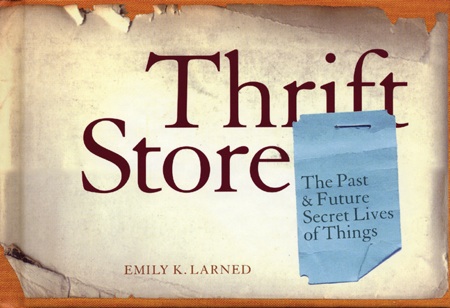
Thrift Store. The
Past and Future Secret Lives of Things (Ig Publishing, October
2005) is the glossy coffee table edition, with more pictures, printed in
China (full color, hardcover, 96 pages, 5,000 copies). I bought copies
of this to give to friends, too. I commend it to your attention.
I am on my way to the NYRSF Reading Series, Kit Reed and John Crowley, at the South Street Seaport Museum. I may make a midnight post, too.
Just back from the NYRSF reading in the Melville Gallery of the South Street Seaport Museum, well attended, with Jim Freund introducing each reader and recording the event for broadcast on Hour of the Wolf. Kit Reed read a section from her recent novel, The Baby Merchant (Tor, 2006), a pitch perfect monologue in the character of a successful psychopathic entrepreneur. John Crowley read a section of a novel-in-progress, a nested series of memories of two brothers Hendrik and Jules Van Dam, about early aviation pioneers, cutting edge technologies of the past, travel, and loss, with an absolutely gorgeous kinetic paragraph tucked in, manifesting the balance of instabilities required to achieve heavier than air flight. So fine a string of sentences that I will not mangle it by inaccurate citation, and will look forward to reading the book.
On Thursday 8 February (7 : 00 p.m.), at the Swiss Institute — Contemporary Art, 495 Broadway, 3rd Fl., N.Y.C. (T. 212.925.2035) I will be reading the Arabic originals of poems by Abdelkrim Tabal translated by Rabia Zbakh and Wendy Walker (who will read the English poems). Other readers include translators Emily Moore and Matthew Zapruder reading poetry translated from Spanish and Romanian.
5 February 2007
The Summer Reading Room (also known as the attic)
With the afternoon sun coming through the north window ; the ambient temperature
today, approx. 0 degrees C. / 32 degrees F. — this
tends to make research during winter very efficient.

4 February 2007
John
Crowley & Kit Reed at the South Street Seaport Museum
Just saw the announcement for the February instalment of The New York Review
of Science Fiction Reading series, this Tuesday evening (6 February). Not
to be missed :
Kit Reed / John Crowley
Tuesday, 6 February, at 7 : 00 p.m. — Doors open 6 : 30
p.m.
$5 suggested donation
South Street Seaport Museum’s Melville Gallery
213 Water Street (near Beekman)
Kit Reed has a sharp eye and a great sense of satire. She read from Thinner
Than
Thou (Tor, 2004) when I shared at bill with her at KGB. And I have
been an admirer
of John
Crowley for many years. This is a bonanza year for him (and for his readers),
with
the
fourth
volume
of
the Ægypt series, Endless Things,
due
out from Small Beer Press in May. And then there is
The 25th Anniversary Edition of Little, Big, to be designed by John Berry and published by Incunabula of Seattle, the press of Ron Drummond (whose blog includes an account of his editorial research in the Crowley archive at the HRC in Austin).
Little, Big (1981) is simply the best American novel of the past twenty-five years, no matter what the writers and editors of The New York Times Book Review decided.
3 February 2007
Rudy
Rucker, Gnarly Power Chords, and Carnegie Hall
I guess I hadn’t quite finished with Rudy Rucker’s latest books : Mad
Professor. The Uncollected Stories
(Thunder’s Mouth Press, 2007), and the novel Mathematicians in Love (Tor,
2006). There are some choice sentences (“ I tend to tell my life
story as if eveything were funny, even though it’s not. ”)
and lots of fun ideas. But beyond the ideas explored
in specific stories, Mad Professor had
a useful restatement of Ezra Pound’s “ make it new ” in
science-fiction terms. Rucker mentions “ power
chords in the context of fantastical literature ” :
classical tropes that have the visceral punch of heavy musical riffs [. . .] When I use a power chord, I try to do something fresh with the trope [. . ] I like it when my material takes on a life of its own. This leads to what I call the gnarly zone. [. . ] In short, a gnarly process is complex and unpredictable without being random.
Last night (2 February) we went to the Welcome to Dreamland concert at Carnegie Hall, which was strange and delightful right from the opening measures of CocoRosie and the vocal antics of Cibelle in a turquoise Isadora Duncan style toga. They didn’t play this stuff in Carnegie Hall even in the 1960s. We particularly wanted to see Adem and Devendra Banhart. I first heard Adem in June when a friend in London sat me down and played Love and other planets, the title track of his new record (Domino records). Just listen, she said.
Adem walks the the razor edge boundary separating the the fields and skies we know and a vast universe of possibility. His lyrics are simple and direct, his sincerity is manifest, and the whole album is science fiction. Love and other planets re-invents the known solar system during a walk out of doors on a clear winter night :
And normally
It’s bright enough to see
With a naked eye
One
reason the song avoids triteness is Adem’s ability to include
devastating hints (and an equal ability to know when nothing more needs
to be said) :
“ We’ll
be breathing ghosts / And they don’t want us to see / So they
join the clouds / Which clot above our heads ”.
Then there is Crashlander :
Crashlander
There’s damage, but at least you’re alive
The hardest thing you could have done, you’ve done now
It gets easy from hear
[ . . .]
Pull yourself free
With the wreckage at your feet
There’s a million worlds to explore
When you’re ready the cosmos is yours
Yours.
The album grew on me, and we were lucky enough to see Adem at his New York solo debut at the end of August, at Joe’s Pub, a small space where his honesty and visionary qualities were shining. He called Love and other planets his space theme album, and later said he reads science fiction. At Carnegie Hall, his sincerity and happiness were compelling when he sang Spirals, a brilliant piece with micro/macro shifts :
If our galaxy
And Andromeda
[. . .] join
At six billion lives per second
And they danced around
Linking spiral arms
As they’d spin
Spin through infinity
They couldn’t feel as vast
As I feel now
Toward the end of the show, Devendra Banhart and his rhythm guitarist were there on stage at Carnegie Hall, working the power riffs and making it fresh, with lyrics and demeanor alternating between earnest and absurd. A splendid place to see any excellent performer. The cognitive dissonance between the formal venue & the spontaneity of the performers added to the pleasure.
Up in the attic today (also known as the summer reading room, photo
to come).
I found a page of my notes from an editorial meeting during my days at AB
Bookman’s Weekly , probably after writing my first column or batch
of reviews. I found a string of words :
write in English, snotty, too erudite, always remember who you are writing for.
These must have been the criticisms of the editor, Jacob L. Chernofsky. He forbade me the use of colons and semi-colons ; or tried to.
Even
as I learned to write short sentences when necessary, I retained my love
of the art of pushing two ideas or images together in a
single sentence ; and watching the sparks fly. In addition to the
unceasing book reviews, I wrote a number of articles on topics that interested
me :
the archives of fantasy author and military historian Fletcher Pratt ;
Arabian explorer H. St. John Philby (father of the spy named for Kipling’s
masterpiece, Kim) ; and the Dutch Orientalist and novelist, R. H. van Gulik.
I found tearsheets of the van Gulik essay, too. He was someone who seemed
to have
attempted to get outside the expectations of his class and training. It
remains
a
useful
short
introduction to his life and fiction, so I have pulled it out of the archives
and posted it here as a separate file ;
I will probably add a few more pictures in due course.
The article
on van Gulik led
me
to
discover
the
work
of
another
Dutch
author who writes in English, Janwillem
van de Wetering.
2 February 2007
Yesterday’s serious post, with its critical vocabulary of crunchy, distressing words on the origins of the Gothic (confinement, contradiction, intrusion, marginalization ? oh, and I forgot to cite : “ artistic antinomy ” & “ paradox at the level of artistic representation ”) prompted an interesting note from Jacob McMurray of Seattle whose blog in lieu of design portfolio is lots of fun. Jacob has a good eye for visual/verbal interplay. He is the publisher of the venerable press of Payseur & Schmidt, founded in 1912 in the utopian community of Cauheegan, Wisconsin.
Some
of the history of the press and emerges in the interview with
Jeff VanderMeer :
"In an effort to maintain the reality and historicity of Payseur & Schmidt, we urge you, at the expense of very real lives, to maintain our illusion, or what you may think of as illusion. In actuality, it is most certainly not. For we sincerely believe that by wishful thinking and force of will, we can continue to sustain the actual existence of Cauheegan, Wisconsin, and its main industry, Payseur & Schmidt."
I look forward to receiving from Jacob the bibliographical description (and photocopies or photographs of the title pages) of two notorious books from the early years of the press (“ F.R. Laramie’s Red Moon Rising is a prime example . . . of the perverse direction our great nation is taking . . . ever closer to the abyss . . . Publisher Payseur & Schmidt . . . should be investigated for treason or more serious crimes. ” ? Saturday Evening Post review, June 27, 1931).
Speaking of visual/verbal interplay (a persistent interest of mine), one splendid book that I came across last summer is Land of the Snow Men. Written and Illustrated by George Belden. While undertaking a Commission for the Philadelphia Explorers’ Club. Antarctica 1913. Manuscript Recovered and Edited by Norman Lock. Illustrations Restored by Derek White (Calamari Press, 2005). The tensions between architecture and madness spill over into the “ unreal geography ” of “ this pure white landscape [. . .] The cold, the hardships ! The unrelenting and ever-present chill of the place ! [. . .] I had gone to bed in Philadelphia only to wake where hell freezes over. ” With its allusions to Verne, Poe, Piranesi ; the deft integration of images with the text of the "rediscovered" manuscript ; and stark, beautiful langauge, this concise book is a sophisticated reflection on the doomed Scott expedition and the potency of the Antarctic in the imagination. To be shelved near At the Mountains of Madness by H. P. Lovecraft.
1 February 2007
Towards a Vocabulary of the Fantastic Narrative
A Specter is Haunting Europe. A Sociohistorical Approach to the Fantastic by José B. Monleón (Princeton University Press, 1990) proves to be a very interesting reflection on the rise of fantastic literature in the middle of the eighteenth century and its development through the early twentieth century (Walpole to Kafka). Monleón discusses how industrialization, efforts to transfer graveyards out of the center of cities, confine the insane and the sick, and marginalize the poor — Reason triumphantly recreating urban life — are closely intertwined with the intrusion of the uncanny, the irrational, and the supernatural into European life and letters. The starting point is the first Gothic novel, published anonymously by Horace Walpole, The Castle of Otranto, A Story, translated by William Marshall, Gent. (1764) ; as early as 1811 Walter Scott noted that Walpole’s novel was “ a new kind of narrative ”. Monleón discusses Goya’s series of etchings of 1799, Los Caprichos, and in particular, no. 43, an early sketch of which makes it clear that
it is the dream and not the sleeep of reason that produces monsters [. . .] The semantic difference is a fundamental one. Instead of articulating a gesture of exclusion, Capricho 43 suggests that there is indeed some continuity between the realms of reason and unreason, the latter being, in fact, a creation of the former (pp. 40-41)
Monleón looks at the evolving nature of the fantastic in authors such as Poe, Henry James, Mary Shelley’s Frankenstein, Bram Stoker’s Dracula, and a chapter on late nineteenth-century Spanish writers whose names are entirely new to me : Bécquer, Galdós, de Alarcon, and others. Developments in technology and ideology are mirrored by shifts in the form of the fantastic narrative.
I turned up this book after reading a mention of it in The Darkening Garden. A Short Lexicon of Horror by John Clute (Payseur & Schmidt, 2006), which I reviewed for a forthcoming issue of The New York Review of Science Fiction.
This creaking and constantly evolving blog of the endless bookshelf : I expect that some entries will be brief, others will take the form of more elaborate essays and eventually I will become adept at incorporating photos or comments and interactivity. Right now you’ll have to send links to me, dear readers. [HW]
electronym : wessells
at aol dot com
Copyright © 2007 Henry Wessells
Produced by Temporary
Culture, P.O.B. 43072, Upper Montclair, NJ 07043 USA.



